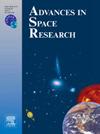Proceeding toward the maximum of solar cycle 25 with a radiation environment similar to the previous cycle
IF 2.8
3区 地球科学
Q2 ASTRONOMY & ASTROPHYSICS
引用次数: 0
Abstract
The Sun exhibited lower-than-average activity levels, including a weak maximum and a prolonged minimum in the solar cycle (SC) 24. Thiswas following a 60-year trend of weakening solar activity, leading to speculations that we could be moving into another secular minimum scenario like the Dalton or the Gleissberg periods. During such periods, the fluxes of galactic cosmic rays (GCRs) increase significantly, introducing radiation hazards for long-term crewed space explorations. In our previous work, we predicted the level of solar activity, and thus, the radiation environment for SC25 will be similar to SC24. In this paper, we show that, to date, the radiation environment observed by CRaTER has been similar to SC24, as we predicted. Furthermore, we predict that if the radiation environment remains similar to SC24, the maximum value for permissible mission duration (PMD) for SC25 will be days based on NASA’s latest permissible exposure limit (PEL).
进入太阳周期 25 的最大值,辐射环境与上一周期相似
太阳活动水平低于平均水平,包括在太阳周期(SC)24中出现了一个微弱的最大值和一个长时间的最小值。这是继 60 年来太阳活动减弱的趋势之后的又一次太阳活动减弱,从而导致人们猜测我们可能会进入另一个类似道尔顿或格莱斯伯格时期的周期性极小期。在这一时期,银河宇宙射线(GCR)的通量会显著增加,给长期载人太空探索带来辐射危害。在我们之前的工作中,我们预测了太阳活动水平,因此 SC25 的辐射环境将与 SC24 相似。在本文中,我们表明,迄今为止,CRaTER 观测到的辐射环境与 SC24 类似,正如我们所预测的那样。此外,我们还预测,如果辐射环境仍然与 SC24 类似,那么根据 NASA 最新的允许暴露限值(PEL),SC25 的允许飞行任务持续时间(PMD)最大值将为天。
本文章由计算机程序翻译,如有差异,请以英文原文为准。
求助全文
约1分钟内获得全文
求助全文
来源期刊

Advances in Space Research
地学天文-地球科学综合
CiteScore
5.20
自引率
11.50%
发文量
800
审稿时长
5.8 months
期刊介绍:
The COSPAR publication Advances in Space Research (ASR) is an open journal covering all areas of space research including: space studies of the Earth''s surface, meteorology, climate, the Earth-Moon system, planets and small bodies of the solar system, upper atmospheres, ionospheres and magnetospheres of the Earth and planets including reference atmospheres, space plasmas in the solar system, astrophysics from space, materials sciences in space, fundamental physics in space, space debris, space weather, Earth observations of space phenomena, etc.
NB: Please note that manuscripts related to life sciences as related to space are no more accepted for submission to Advances in Space Research. Such manuscripts should now be submitted to the new COSPAR Journal Life Sciences in Space Research (LSSR).
All submissions are reviewed by two scientists in the field. COSPAR is an interdisciplinary scientific organization concerned with the progress of space research on an international scale. Operating under the rules of ICSU, COSPAR ignores political considerations and considers all questions solely from the scientific viewpoint.
 求助内容:
求助内容: 应助结果提醒方式:
应助结果提醒方式:


